Samarkand, and its Architectural Artwork.
The historic town of Samarkand, located in the large oasis in Zarafshan river valley, in the north-eastern region of Uzbekistan, is considered the crossroads of world cultures with a history of over two and a half millennia. Evidence of settlements in the region goes back to 1500 BC, with Samarkand having its most significant development in the Timurid period of Tamerlane, from the 14th – 15th centuries, when it was capital of the powerful Timurid realm, in shaping the city’s architectural landscape
Samarkand is little known in the outside world that it is the most classic medieval Islamic architectural site in central Asia region. Though the main structures are mostly of similar designs and often look alike, but what attracts most are the different classic artworks of tiles, ceramics, marbles, and to some extent with jewelries. Many historians claim that Samarkand artworks influenced many other regions: Safavids in Persia, the Moghuls in India, and even the Ottomans in Turkey. If you are an Indian and visit Samarkand, it is likely that local people would say “your Tajmahal in India was influenced by our works.”
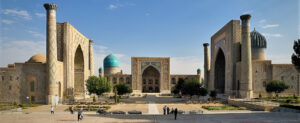
Characteristics of Samarkand Architecture:
• Islamic Influence, integrating their traditional domes, arches, mosaics, calligraphy, and geometric patterns.
• Integration of Art and Architecture: The structures of artworks, intricate tilework, calligraphy, and other decorative elements enhancing their beauty and significance.
• Cultural Crossroads: Samarkand’s location on the Silk Road facilitated cultural exchange, leading to a unique blend of architectural styles and influences.
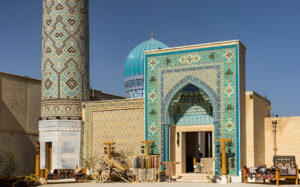
Whatever could survive through series of invasions, battles and destructions, Samarkand’s architecture and specially the Islamic artworks earned its own fame, particularly the Registan Square with its three magnificent madrasahs. all originally built in mud brick with decorated ceramic and tiles. These buildings reflect the city’s rich Timurid heritage and its role as a cultural and architectural crossroads.
Registan,
Samarkand’s most iconic square has three 15th – 17th century madrassahs: the central Ulugbek Madrasah (built in 1420), flanked by the Sher-dor Madrasah (built in 1636) and Tillya-Kari Madrasah (built in 1660). These madrassahs once served as spiritual educational institutions for Islamic studies. Each madrasah features cells (living quarters), a mosque, and an inner courtyard. Well-preserved to this day, the entire complex is recognized as a UNESCO World Heritage Site.
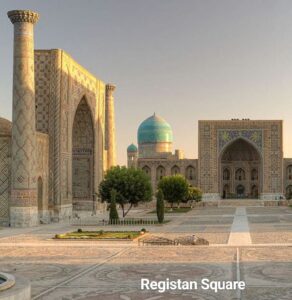
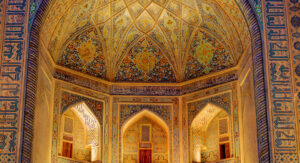
Gur-Emir Mausoleum
Gur-Emir Mausoleum houses the remains of Tamerlane (Amir Timur). Timur initially built the tomb in 1404 for his grandson, but after his sudden death in 1405, he was laid to rest there, despite his original intention to be buried in his hometown of Kesh (modern-day Shakhrisabz).
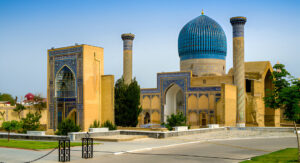
The mausoleum also serves as the final resting place for Timur’s sons, Shahrukh and Miran Shah, grandsons Ulugbek and Muhammad Sultan, his teacher Mir Said Baraka, and several other members of the Timurid dynasty.
His mausoleum, the Gur-e-Amir is one of the gems of Islamic art. Within the sepulchre he lies under a huge, broken slab of jade. The tomb was opened in 1941, having remained intact for half a millennium. The Soviet Archaeological Commission found the skeleton of a man who, though lame in both right limbs, must have been of powerful physique and above-average height.
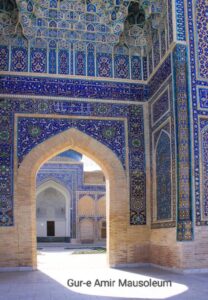
Timur’s most lasting memorials are the Timurid architectural monuments of Samarkand, covered in azure, turquoise, gold, and alabaster mosaics; these are dominated by the great cathedral mosque, ruined by an earthquake but still soaring to an immense fragment of dome.
Bibi-Khanum Mosque
It was constructed during 1399 – 1404 in honor of Amir Timur’s wife. It is one of the largest mosques in Central Asia
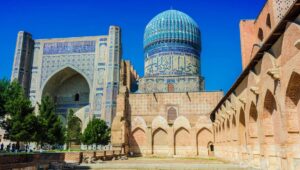
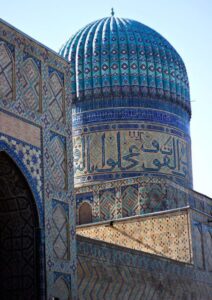
It is said that the ruler personally oversaw the building process. Inside mosque’s courtyard stands a large stone platform for the Quran, the holy book of Islam. Legend has it that if a childless woman crawls under the stand, she may become pregnant.
Shah-i-Zinda
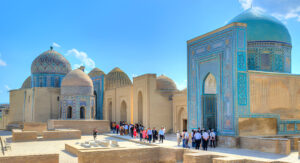
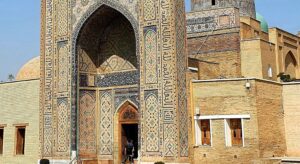
Shah-i-Zinda is a distinctive medieval necropolis adorned in blue hues. Along a narrow, elongated street lie the mausoleums of prominent Samarkand residents from the 11th to 15th centuries. To reach the necropolis, visitors must ascend a flight of stairs. It is believed that those who count the same number of steps going up and coming down are fortunate individuals whose wishes will come true.
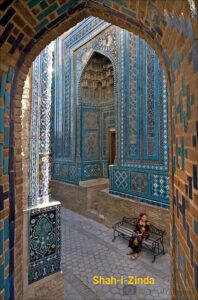
Ulugbek Observatory
Dating back to 1420, it was discovered during archaeological excavations in 1908, and is the remnant of a three-story, cylindrical observatory. The observatory was led by Ulugbek, Amir Timur’s grandson.
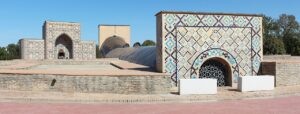
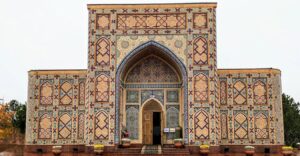
Excavations unearthed a unique measuring instrument, a sextant, which was used to determine the altitude of the sun and stars. The mystery of its whereabouts was solved by Russian archaeologist Vladimir Viyatkin. Unfortunately, the underground section of a vast meridian arc, was destroyed by a fanatic in 1449. Quadrant arc of 63m in length was used to chart the progress of celestial bodies across the sky. Using this arc, Samarkand’s medieval astronomers produced a star catalogue charting the movements of 1,018 stars, which was still known and studied in Oxford in the 17th century.
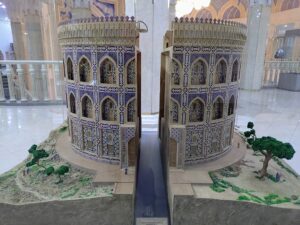
In the picture, the central partition hosted the huge sextant. It was the largest 90° quadrant the world had ever seen, though it is called a sextant as only 60° were used. Deeply embedded in the rock to lessen seismic disturbance, the surviving 11-metre arc sweeps upwards in two marble parapets cut with minute and degree calibrations for the astrolabe that ran its length. The arc completed its radius at the top of a three-storied building.
Saint Daniel’s Tomb (Mausoleum of Khoja Daniyar
It is a revered mausoleum believed to be the burial place of the biblical prophet Daniel and a site frequented by followers of Islam, Orthodoxy, and Judaism.
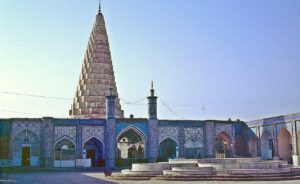
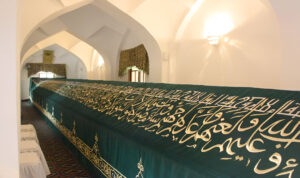
According to legend, prophet Daniel (Daniyar) is buried here, while another group says the tomb belongs to Khoja Daniyar, an associate of Prophet Muhammad’s cousin. Regardless, hundreds of pilgrims from the three faiths visit daily. It is a significant pilgrimage site for people of various faiths, including Muslims, Christians, and Jews. The tomb is known for its unusually long sarcophagus, traditionally attributed to the prophet’s body growing by 5 cm per year, though this is a popular legend. A holy spring flows near the grave, and many claim to have experienced healing after drinking its water.
Sher-Dor Madrasah
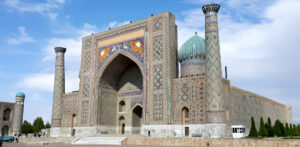
Sher-Dor Madrasah (Sherdor) was built between 1619 and 1636. The name translates to “Madrassah with Lions”. It was built by order of Ashtarkhanid Yalantgush Bahadur on the site of the dismantled Khanaka of Ulughbek. Samarkand architect Abdulzhabbor was involved in the construction, and the decoration was made by the master Muhammad Abbas. At first, the building was planned to be named after governor Yalangtush Bahadur. However, the people called the building “Sher-dor”, which translates as “The Abode of Lions”.
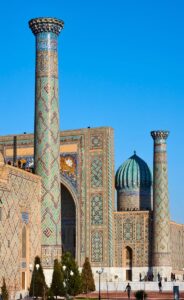
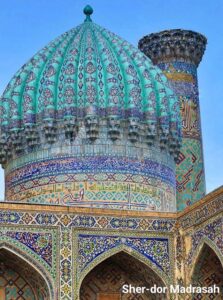
The outside and inside are decorated with bright ornaments of glazed brick, walls and towers are covered with majolica of various patterns of climber flowers and quotations from Kuran on Arabic. But some part of finishing is irretrievably lost, though scientists, historians and restorers try to recover the initial appearance of Sher-Dor Madrasah.
*******
In addition, Samarkand has numerous other sites

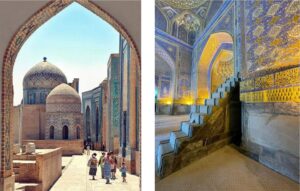
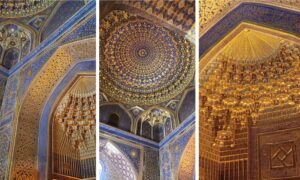
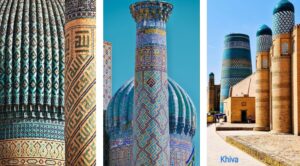
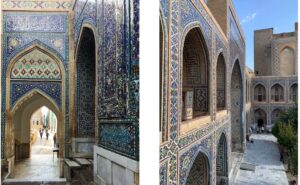
******
Though the subject is the architectural artworks, it’s important to narrate the history of Samarkand in as short as possible.
Samarkand city in east-central Uzbekistan is one of the oldest cities of Central Asia. Known as Maracanda in the 4th century BCE, and the capital of Sogdania, it was captured by Alexander the Great in 329 BCE. The city was later ruled by Central Asian Turks (6th century), the Arabs (8th century), the Samanids of Iran (9th – 10th century), and Turkic rulers (11th to 13th century) before it was annexed by the Khwarezm Shah dynasty (early 13th century) and then destroyed by the Mongol conqueror Genghis Khan (1220). After a revolt, against the Mongol rulers (1365), Samarkand became the capital of Timur (Tamerlane) empire, who made the city an important economic and cultural centre in Central Asia. Samarkand was again conquered by Uzbeks in 1500 and became part of the khanate of Bukhara. In 1887, it became a provincial capital of Russian Empire. Briefly (1924 – 36) it was the capital of Uzbek Soviet Socialist Republic. So, after so many wars, annexations and destructions, today Samarkand is an old city dating from medieval times and a new section built after the Russian conquest of the area in the 19th century.
In 1398 Timur invaded India on the pretext that the Muslim sultans of Delhi were showing excessive tolerance to their Hindu subjects. He crossed Indus River on 24th of September and marched on Delhi. On 17th of December, Delhi Sultan Mahmud Tughluq’s army was massacred at Panipat, and Delhi was reduced to a mass of ruins, from which it took more than a century to emerge. By April 1399 Timur was back in his own capital. Spanish diplomat Ruy Gonzalez de Clavijo, who traveled to the court of Timur (Tamerlane) at Samarkand, reveals that 90 elephants were employed to carry stones from quarries to erect a mosque at Samarkand.
Timur began his rise as leader of a small nomad band and by guile and force of arms established dominion over the lands between the Oxus and Jaxartes rivers (Transoxania) by the 1360s. For three decades, led his mounted archers to subdue each state from Mongolia to Mediterranean. He was the last of the mighty conquerors of CentralAsia to achieve such military successes as leader of the nomad warrior lords, ruling both agricultural and pastoral peoples on an imperial scale.
References:
https://www.britannica.com
https://whc.unesco.org
https://www.advantour.com/uzbekistan
https://www.silkroad-samarkand.com
https://www.lonelyplanet.com/destinations/uzbekistan
https://www.centralasia-travel.com
https://www.backpackadventures.org
https://www.eyeonasia.gov.sg
Wikipedia
*******

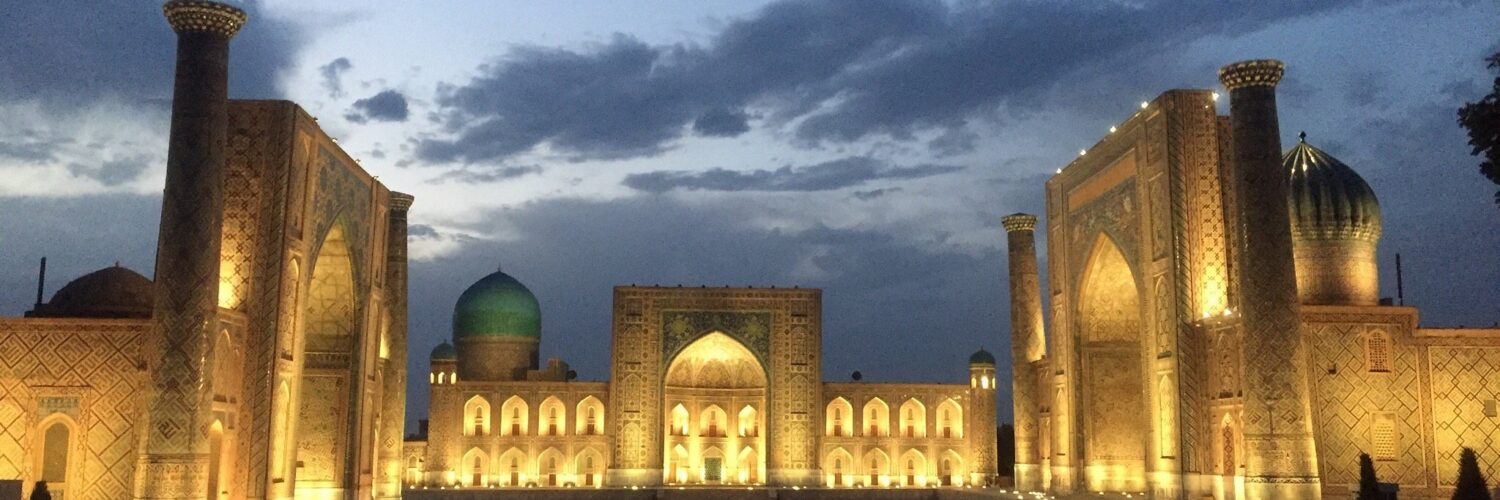













আপনার আরও একটি অসাধারণ লেখা। সমরখন্দ যে মধ্যযুগীয় স্থাপত্যে এবং শিক্ষাকেন্দ্র ও অন্যান্য শিল্পকলায় এত সুনাম অর্জন করেছিল, এটা আমার জন্য ছিল না।
আর ছবিগুলি অসাধারণ। ছবিগুলিই আপনার বক্তব্য বর্ণনা করে দেবে।
পড়ে খুব ভালো লাগলো।
It’s pleasure to read such articles.
Yes, Samarkand was the islamic education and cultural hub of medieval times. It’s timeline is much before our Mughol era of India, and so some extent the Mughal era structures were certainly influenced by Samarkand styles.
The attached pictures are superb and superb.
Thanks for the write up.
Though it was the hub of medieval Islamic education, art and culture, and it flourished across vast Asian territory, it is still an unknown destination for the travellers who are interested for a visit to such sites.
The artwork of tiles, and mosaic as I can see in the pictures here, are superb, and that takes us to a visit of medieval Samarkand. The write up has planted an interest in my mind to learn more about Samarkand, (don’t know if I would be able to visit physically).
Good write up.
Thanks author.
মধ্য এশিয়ার মধ্যযুগীয় স্থাপত্য বা তার কারুকার্য এবং সৌন্দর্য লিখে বোঝানো সম্ভব নয়। আপনি চেষ্টা করেছেন, আর এই বিষয়ে আরও কতজনকে অবহিত করছেন, এজন্য আপনাকে ধন্যবাদ জানাই।
আরও একটি গুরুত্বপূর্ণ কারণ, সিল্ক রুট এই অঞ্চল দিয়ে গেছে, তাই উভয় দিকের নানান তথ্য সমরখন্দ এসে পৌঁছাত। সব মিলিয়ে শিক্ষা, শিল্প বাণিজ্য কলার আদর্শ সঙ্গমস্থল।
আর এই লেখায় ছবিগুলোর প্রশংসাও করতেই হয়।
আরেকটা খুব সুন্দর লেখা পড়লাম।
মধ্য এশিয়ার অন্য দেশগুলোর মধ্যে উজবেকিস্তান ছিল জ্ঞান, শিল্পের চর্চাকেন্দ্র। আপনার ছবিগুলিতে দেওয়া অতি সূক্ষ্ম মার্বেল, টাইলস আর সেরামিকের কাজগুলি মুগ্ধ করে দেয়।
আমিও অনেকের থেকে শুনেছি (প্রামাণ্য কিনা জানিনা) যে তাজমহল নাকি সমরখন্দ আর বুখারা র fine artwork এ influenced হয়েছিল।
আপনার লেখার দৌলতে সমরখন্দ ঘুরে এলাম।
Not only the architecture is notable classic, another important aspect is that the structure was so well built that these are maintained for 5/6 centuries with great care.
Amongst surrounding counties, Uzbekistan was the most promising in terms of both education and culture.
This is another good write up of the author.
Thanks for the informative article.
I have not read much about the place, it’s people or their history. So the text gives me a lot of new information. Very nicely written, with all good photos.
The architecture are classic, and reminds me of our Mughol styles, to certain extent. I wish I should make a visit.
ছবিগুলি দেখে ফতেপুর সিক্রি বুলন্দ দরওয়াজা মনে আসে। Interior artwork আলাদা কিন্তু স্থাপত্যের স্ট্রাকচারে অনেক মিল আছে মনে হলো।
এই লেখাটি পড়ে অনেক কৌতূহল হলো, সমরখন্দ ইতিহাস পড়তে হবে।
The credit of the nice composition is that author could create some curiosity with me, probably with others also as it was a unknown part of history. At least I have never read earlier.
The text and supporting photos made the composition interesting.
Truly a pleasure to read.
Interesting, specially the pictures.
I have seen some of the Islamic structures in Europe but it seems Asian architectures are different and have their own style, probably because of philosophy.
Nice to read, I wish I should visit once.
Thanks
The pictures are superb, as if I wish to be there and see direct. Narrations are short but ok for me. The overall presentation is nice, I could get the glimpses.
মধ্য এশিয়ার স্থাপত্য শিল্পের কথা লোকমুখে শুনেছি কিন্তু এবিষয়ে লেখালেখি খুব একটা চোখে পড়েনি। এই লেখাটি পড়ে মোটামুটি একটা ধারণা নিশ্চয়ই করতে পারি, আর সাথে অপুর্ব ছবিগুলিও লেখার আকর্ষণ বাড়িয়েছে।
আপনার বিভিন্ন বিষয়ের বৈচিত্র্য আমার ভালো লাগে। আপনি এইভাবেই অল্প জানা বিষয়গুলি লিখে তুলে ধরুন।
আপনাকে অনেক ধন্যবাদ জানাই।
আপনার লেখাটা পড়ে ভালো লাগলো। এদের interior artwork খুবই উচ্চ মানের। আপনার দেওয়া ছবিতে সেগুলি বোঝা যায়।
ধন্যবাদ, এরকম আরও কিছু লিখুন।
The beauty of any write up is to generate curiosity in readers’ mind, and my author could do it, specially collecting all beautiful photos.
I read it, and recently Govt of Uzbekistan is also promoting the site in social media. I wish I should go one day.
An unparalleled travelogue! I’m confused, which part is better : the photos or the write-up?! 😳